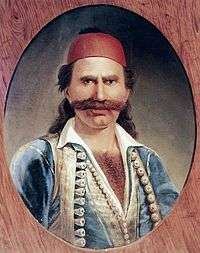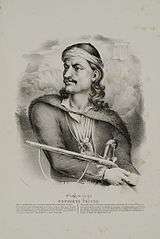Odysseas Androutsos
Odysseas Androutsos (Greek: Οδυσσέας Ανδρούτσος; 1788–1825; born Odysseas Verousis; Greek: Οδυσσέας Βερούσης) was a hero of the Greek War of Independence.
Odysseas Androutsos | |
|---|---|
 Portrait by Dionysios Tsokos | |
| Birth name | Odysseas Verousis |
| Born | 1788 Ithaca, Republic of Venice |
| Died | June 5, 1825 (aged 37) Athens, Greece |
| Battles/wars | Battle of Gravia, Battle of Vassilika |
| Relations | Andreas Verousis (father) Akrivi Tsarlampa (mother) |
Early life

He was born in Ithaca in 1788; his family was from the village of Livanates in Phthiotis prefecture. His father was Andreas Verousis, an Arvanite klepht from Livanates, while his mother was from Preveza.
After losing his father, Androutsos joined the army of Ali Pasha and became an officer; there he also became an alevit (bektashi), just like Ali Pasha.[1] However, in 1818 he joined the Filiki Eteria which was planning the liberation of Greece from the Ottoman Empire.
Greek Revolution
In May 1821, Omer Vryonis, the commander of the Ottoman army, advanced with 8,000 men, after crushing the resistance of the Greeks at the river of Alamana and putting Athanasios Diakos to death, headed south into the Peloponnese to crush the Greek uprising.
Odysseas Androutsos with a band of 100 or so men took up a defensive position at an inn near Gravia, supported by Panourgias and Diovouniotis and their men. Vrioni (Vryonis) attacked the inn but was repulsed with heavy casualties (over 400 dead). Finally, he was forced to ask for reinforcements and artillery, but the Greeks managed to slip out before the reinforcements arrived. Androutsos lost two men in the battle and earned the title of Commander in Chief of the Greek forces in Roumeli.
In the following year, May 1822, he clashed with political opponent Ioannis Kolettis and the Areopagus of Eastern Continental Greece. He was accused for collaboration with the Ottomans and the government dismissed him from commander.
However, soon, he was restored and kept command in Eastern Central Greece. In September 1822, Androutsos, on the instances of the Athenian municipal authorities, with Gouras and Makrigiannis took control of the Acropolis in Athens which had capitulated in June. To ensure the occupation he had a bastion built to protect the ancient Klepsydra spring, which had just being rediscovered by chance on the north-western slope of the rock.[2] During the next year (1823), he passed to Euboea to fight against and clear it from Turks.
Downfall
In early 1825, as Greek internal divisions intensified, Androutsos began a correspondence with Omer Pasha of Karystos, offering to hand over the Acropolis if aided by Ottoman troops and placed in control of the districts of Livadia, Thebes, and Atalanti. Though the terms of their agreement are not preserved in Ottoman archives, Androutsos was sent a firman granting him amnesty. He joined forces with the Ottoman army to defend the villages around Livadia. After promised reinforcements failed to arrive, he retreated but was captured by Greek insurgents.[3] The revolutionary provisional government placed him under arrest in the Frankish Tower of the Acropolis of Athens, accusing him again for collaboration with the Ottomans. The new commander, Yannis Gouras, who once was Androutsos' second in command, ordered his execution on June 5, 1825. Androutsos' sister Tersitsa married Edward John Trelawny, who commanded Androutsos' forces in his absence.
See also
- Battle of Gravia
References
- Η μάχη της Γραβιάς
- AL. N. Œkonomides. L'Acropole d'Athenes. Editions K. Gouvoussis, p. 21
- H. Sukru Ilicak, "Revolutionary Athens Through Ottoman Eyes", in Georgopoulou, M. and Thanasakis, K. [eds.], Ottoman Athens: Archaeology, Topography, History, (Athens 2019), pp.249–252.